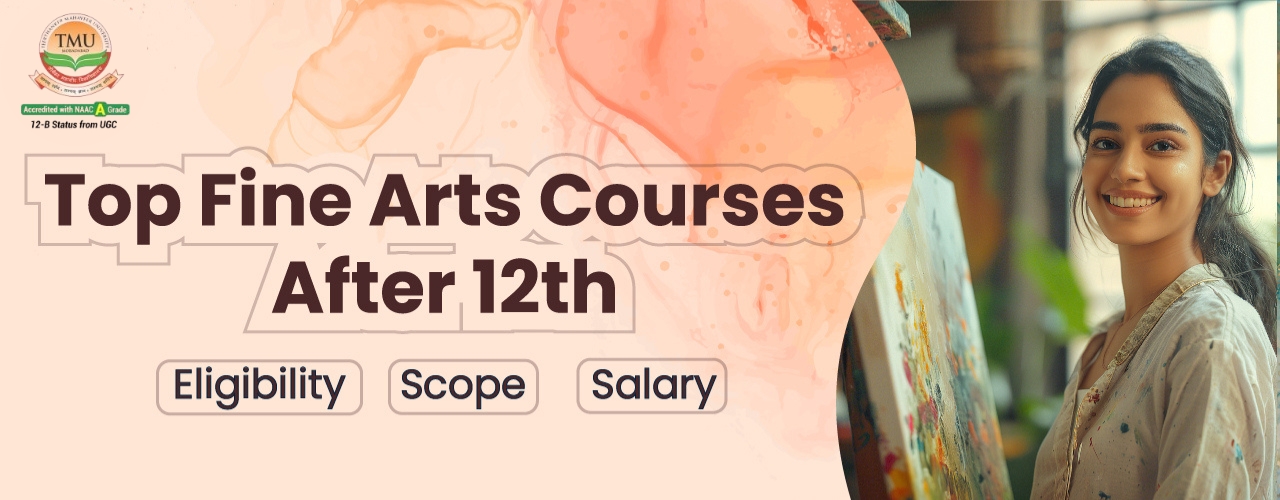Top Fine Arts Courses After 12th: Eligibility, Scope, and Salary
Table of Contents
Fine arts is no longer just a passion—it's a legitimate and flourishing career path. In today’s fast-evolving world, the value of creativity, aesthetics, and artistic expression is at an all-time high. From animation studios to art galleries, from UX design labs to branding agencies—fine arts professionals are in demand everywhere.
Gone are the days when pursuing a career in the arts was considered risky. Today, the creative industry is booming, and the digital revolution has opened countless opportunities for aspiring artists. Enrolling in a fine arts course after 12th grade allows students to explore disciplines like painting, design, sculpting, and digital arts. This fine arts course equips learners with both creative skills and technical expertise, preparing them for dynamic careers in animation, graphic design, visual arts, and other thriving creative fields.
This blog explores the top fine arts courses available after 12th grade, their eligibility requirements, scope, and potential salaries. If you’re wondering whether Fine Arts is the right fit for you, stick around—we’ve got answers!
What is Fine Arts?
Fine arts refers to creative art forms that are primarily developed for aesthetic and conceptual value, rather than for practical functions. Fine arts encompass traditional fields such as painting, drawing, and sculpture, along with newer disciplines like digital art, graphic design, and animation.
There are five main branches of fine arts:
- Visual Arts: Painting, Drawing, Photography, Sculpture
- Performing Arts: Dance, Music, Theatre
- Applied Arts: Graphic Design, Interior Design, Industrial Design
- Literary Arts: Poetry, Creative Writing
- Multimedia Arts: Animation, VFX, Digital Media
With technological advances and digital creativity booming, fine arts are blending the traditional with the modern. This fusion is opening exciting new avenues in careers, from working in blockbuster animation films to designing interfaces for global tech companies.
Fine Arts is ideal for students who:
- Have a strong visual imagination
- Enjoy experimenting with colour, shape, and form
- Are passionate about storytelling through art
- Want a non-traditional, flexible career path
It’s not just about painting anymore—it's about expression, identity, and storytelling across platforms.
Teerthanker Mahaveer University
Apply for Admission
Click Here To Apply for Admission
Eligibility Criteria for Fine Arts Courses After 12th
Before diving into your dream art career, you need to understand the eligibility requirements. While fine arts programs value creativity more than grades, some basic eligibility criteria still apply:
Academic Requirements
- You must have completed 10+2 (any stream) from a recognised board (Arts, Science, or Commerce).
- Some universities require a minimum aggregate score of 50%, especially for degree courses.
- English is often a preferred language, as many art courses are taught in it.
Entrance Exams and Portfolios
- Top colleges like Sir JJ School of Art and Delhi College of Arts conduct entrance tests.
- Some institutions may ask for a portfolio showcasing your creative work.
- Popular entrance tests include:
- NIFT/NID (for design-oriented courses)
- UCEED
- Private university-specific exams
Skillset and Personal Traits
- Creativity and imagination
- Visual communication skills
- Attention to detail
- Open-mindedness and willingness to experiment
- Time management and discipline
Bonus Tips:
- Start building your portfolio in school.
- Attend workshops, exhibitions, and online art communities.
- Take online pre-foundation courses if you’re aiming for top art schools.
In short, eligibility is quite flexible. If you're creative, curious, and willing to work on your craft, Fine Arts welcomes you with open arms!
Why Choose Fine Arts After 12th?
Still unsure if Fine Arts is the right path? Let’s break it down. Fine arts isn’t just a fallback or a hobby—it's a career that can be deeply rewarding, both personally and professionally.
1. Expression of Individuality
Unlike conventional careers, fine arts allow you to express your identity. Your art becomes your voice, and that’s powerful. Whether you're into abstract painting, digital storytelling, or sculpture—your creativity has no limits.
2. Wide Career Opportunities
From galleries to games, from classrooms to commercials—fine arts graduates are everywhere. Popular career paths include:
- Visual Artist
- Graphic Designer
- Animator
- UX/UI Designer
- Illustrator
- Art Therapist
- Art Educator
3. Financial Growth
Yes, you can earn well in fine arts. Entry-level jobs may not be six-figure right away, but experienced professionals and freelancers often make lucrative incomes. Plus, your work can become a brand over time.
4. Global Demand
Art is universal. Fine arts professionals often work with clients worldwide. Your portfolio is your passport—no visa needed!
5. Personal Fulfilment
Creating something original provides unmatched satisfaction. If you're someone who thrives on creativity, this field can be deeply satisfying and mentally rewarding.
In a world full of conformity, choosing fine arts means choosing to stand out. It's about turning passion into a profession—and that's a beautiful thing.
Top Fine Arts Courses After 12th
Here comes the exciting part: the courses!
Here’s a quick table summarising the top fine arts courses after 12th, along with their eligibility, duration, and average salary:
| Course Name | Duration | Eligibility | Average Salary (INR) |
| BFA (Bachelor of Fine Arts) | 4 Years | 12th Pass (Any Stream) | ₹3-6 LPA |
| BVA (Bachelor of Visual Arts) | 4 Years | 12th Pass + Portfolio | ₹3-5 LPA |
| BA in Fine Arts | 3 Years | 12th Pass (Arts/Any) | ₹2.5-4 LPA |
| Diploma in Fine Arts | 1-2 Years | 12th Pass | ₹1.8-3 LPA |
| Certificate Courses | 6-12 Months | Open to All | ₹1.5-2.5 LPA |
Let’s now break down each course, starting with the most popular—Bachelor of Fine Arts (BFA).
Bachelor of Fine Arts (BFA)
The Fine Arts course (BFA – Bachelor of Fine Arts) is a popular undergraduate programme for students passionate about painting, sculpture, design, or performing arts. It blends theory with hands-on studio practice, helping students master artistic techniques while developing creative expression. By pursuing a fine arts course, students gain the skills to build successful careers in art, design, media, and creative industries.
Course Duration and Structure
The BFA program typically spans 4 years, divided into 8 semesters. The curriculum includes both theoretical and practical subjects, focusing on nurturing artistic skills and critical thinking.
Eligibility Criteria
- Completion of 10+2 from any recognised board (Arts, Science, or Commerce).
- Minimum 50% aggregate marks (may vary depending on the institution).
- Some universities conduct entrance exams or require submission of a portfolio.
Specialisations Available
Students can choose from various specialisations such as
- Painting
- Applied Arts
- Sculpture
- Animation
- Photography
- Printmaking
- Visual Communication
These specialisations allow students to focus on their area of interest and master specific skills relevant to their future careers.
Career Scope
Graduates with a BFA degree can explore multiple avenues:
- Graphic Designer
- Illustrator
- Art Director
- Animator
- Visual Artist
- Multimedia Specialist
- Museum Curator
They can work in advertising agencies, media houses, animation studios, publishing companies, or as independent artists.
Expected Salary
The average salary of a BFA graduate ranges from ₹3 to ₹6 LPA (Lakhs Per Annum) depending on skills, experience, and location. Freelancers or those who run their own studios or online art shops may earn significantly more over time.
Why Choose BFA?
- Offers formal training in the arts.
- Opens doors to both government and private sector jobs.
- Serves as a strong foundation for further studies (like MFA or M.Des).
- Helps in building a professional portfolio for global opportunities.
In short, BFA is a comprehensive and structured program that sets the stage for a successful art career.
Bachelor of Visual Arts (BVA)
BVA is another top-tier course, often considered a sibling of BFA. While a BFA might include performing arts, a BVA focuses more on visual mediums like painting, graphic design, and illustration.
Key Differences from BFA
- BVA is strictly focused on visual arts.
- Often includes more design and digital media components.
- Offers courses in aesthetic theory, art history, and visual storytelling.
Course Structure and Duration
- Duration: 4 years
- The curriculum includes visual communication, drawing, sculpture, art history, and elective specialisations like
- Digital Design
- Illustration
- Typography
- Visual Effects
Eligibility
- 10+2 pass from any stream.
- Some institutions require a portfolio review or entrance test.
Career Opportunities
Graduates can work as:
- Visual Designers
- UX/UI Designers
- Concept Artists
- Digital Painters
- Exhibition Designers
- Creative Directors
- BVA grads often find jobs in industries like advertising, gaming, web design, and digital media.
Salary Expectations
Freshers can expect between ₹3 and ₹5 LPA. With experience or freelance projects, earnings can go up substantially, especially for those who specialise in high-demand fields like UX/UI or gaming design.
Why Choose BVA?
- Great for tech-savvy, design-focused students.
- Emphasises modern and digital art platforms.
- Offers strong scope in India’s booming design and tech sectors.
If you want to merge creativity with technology, BVA might be your best bet.
BA in Fine Arts
A Bachelor of Arts (BA) in Fine Arts is more academic and theory-driven than a BFA or BVA. It balances practice with a deeper understanding of the philosophical, historical, and cultural contexts of art.
Duration and Structure
- Duration: 3 years
- Covers topics like:
- Art Appreciation
- Cultural History
- Indian and Western Art Traditions
- Studio Practices
- Visual Analysis
Eligibility Criteria
- 10+2 in any stream (arts preferred).
- Some colleges may require basic drawing or painting skills.
How It Differs from BFA/BVA
- BA is broader, suitable for students interested in academic or curatorial careers.
- Less studio work, more reading and analysis.
- Often leads to careers in art education, criticism, or administration.
Career Opportunities
- Art Historian
- Curator
- Art Teacher
- Cultural Manager
- Researcher in Art Institutions
Salary Expectations
Average salary ranges from ₹2.5 to ₹4 LPA. Those pursuing an MA or PhD in Fine Arts often earn more in academia, galleries, or cultural institutions.
Who Should Choose a BA in Fine Arts?
- Students interested in theory and academic work.
- Those aiming for postgraduate studies in art or design.
- People passionate about preserving and analysing art history.
It’s the perfect course if you love art but don’t want to be limited to painting or designing for commercial purposes.
Diploma in Fine Arts
If you’re looking for a faster, skill-focused entry into the art world, a Diploma in Fine Arts might be ideal.
Duration and Structure
- Duration: 1 to 2 years
- Emphasis on hands-on training
- Focus areas may include:
- Drawing and Sketching
- Printmaking
- Mural Design
- Mixed Media Art
Eligibility
- 10+2 pass (some courses accept students post-10th)
- No entrance test in most cases
Who Should Choose Diploma Courses?
- Students wanting to explore Fine Arts before committing to a full degree
- Working professionals or entrepreneurs seeking creative skills
- Those aiming for specific art jobs like illustrators or muralists
Career Prospects
- Art Assistant
- Junior Illustrator
- Freelance Painter
- Tattoo Artist
- Decorative Artist
These roles often serve as stepping stones to larger freelance careers or business ventures.
Salary
Entry-level jobs offer ₹1.8 to ₹3 LPA, but skilled professionals can scale fast through freelance or private commissions.
Diploma courses are affordable, accessible, and packed with value for students looking to enter the art world quickly.
Certificate Courses in Fine Arts
If you’re looking for short-term, flexible learning, certificate courses in fine arts can be a great option. These courses are perfect for beginners or professionals who want to upgrade their skills without committing to a full-time degree.
Course Duration and Focus
- Duration: 3 to 12 months
- Available both online and offline
- Covers niche areas like
- Watercolor Techniques
- Digital Illustration
- Charcoal Sketching
- Animation Basics
- Calligraphy
These courses are ideal for building a specific skill rather than exploring the whole breadth of fine arts.
Eligibility Criteria
- Open to all, regardless of educational background
- No entrance exams
- Perfect for hobbyists, working professionals, or school pass-outs looking for a creative edge
Career Scope
While these are not substitutes for degree programs, certificate holders can:
- Start freelancing gigs
- Add to their professional portfolio
- Enhance employability in design-related roles
- Pursue higher studies or diploma programs
You can find work as a:
- Freelance Illustrator
- Poster Designer
- Assistant Animator
- Commissioned Portrait Artist
Salary Expectations
Most certificate course holders start with ₹1.5 to ₹2.5 LPA. However, if combined with talent and marketing skills, freelancers can earn much more via commissions, digital prints, and social media exposure.
Why Choose Certificate Courses?
- Learn from the comfort of your home
- Affordable and flexible
- Helps test waters before pursuing full-time art education
Whether you're switching careers or exploring a passion project, certificate courses provide a fast, low-risk way to get started in fine arts.
Career Options After Fine Arts
A degree in fine arts unlocks a world of career possibilities. Whether you want to create, design, teach, or innovate—there’s something for everyone.
Traditional Career Paths
These are rooted in classical art practices and include:
- Painter: Sell artworks, participate in exhibitions, or take commissioned projects.
- Sculptor: Work on public art installations, museum exhibits, or private commissions.
- Art Teacher: Teach in schools or colleges, or run your art academy.
- Printmaker: Specialises in etching, lithography, or digital prints.
Modern Creative Fields
The digital age has opened many doors:
- Graphic Designer: Create logos, brand identities, and visual marketing materials.
- Animator: Work in films, TV shows, games, and digital content.
- UX/UI Designer: Design interfaces for apps, websites, and software.
- Game Designer: Create visual content and environments for gaming platforms.
- Art Director: Lead visual projects in advertising or media agencies.
- Digital Artist: Sell NFTs, illustrations, and webcomics.
Other Emerging Fields
- Art Therapy: Use art as a form of healing for mental health treatment.
- Tattoo Artist: A growing industry blending creativity with body art.
- Curator: Manage art galleries, museums, and cultural spaces.
Self-Employment & Freelancing
Many artists carve their path through freelancing. With a strong portfolio and a social media presence, you can:
- Sell artwork online
- Take international commissions
- Start a YouTube channel or Instagram page for your art
- Launch your own studio or art brand
Salary Expectations in Fine Arts Careers
Salaries in fine arts vary based on skill, experience, location, and type of employment. Here's a quick look at average earnings:
| Role | Entry-Level Salary (INR) | Experienced Salary (INR) |
| Graphic Designer | ₹3–₹5 LPA | ₹6 – ₹12 LPA |
| Animator | ₹2.5 – ₹4 LPA | ₹6 – ₹10 LPA |
| UX/UI Designer | ₹4 – ₹6 LPA | ₹8 – ₹15 LPA |
| Art Director | ₹6 – ₹9 LPA | ₹15+ LPA |
| Freelance Artist | ₹1 – ₹3 LPA (starting) | ₹10+ LPA (with growth) |
| Art Teacher | ₹2.5 – ₹4 LPA | ₹5 – ₹8 LPA |
| Tattoo Artist | ₹3 – ₹7 LPA | ₹10+ LPA (top artists) |
Freelancing and Global Work
Freelancers can work with international clients and earn in dollars or euros. Platforms like Fiverr, Upwork, and Etsy enable artists to reach global audiences.
Income Growth Factors
- Skill Upgradation (learning digital tools like Photoshop, Blender, etc.)
- Building a Personal Brand
- Networking and Collaborations
- Social Media Presence
Fine Arts is a skill-based field. Your income is directly proportional to how well you market your art and evolve with the times.
Scope of Fine Arts in the Future
The future of fine arts is brighter than ever, thanks to the rise of digital platforms, globalisation, and increasing appreciation for creative skills. As industries seek innovation and originality, fine arts professionals are becoming essential across diverse sectors.
1. Digital Transformation
With the integration of technology in art:
- Digital painting, 3D sculpting, and animation are gaining momentum.
- Artists are exploring NFTs (non-fungible tokens) to sell digital artwork.
- Virtual reality (VR) and augmented reality (AR) are creating new mediums for immersive art.
2. Global Exposure
Fine arts isn’t restricted to local exhibitions anymore. Thanks to platforms like Behance, Instagram, and ArtStation, artists can showcase their work to a global audience. International galleries and clients are more accessible than ever.
3. Interdisciplinary Applications
Fine Arts is now merging with:
- Psychology (Art Therapy)
- Technology (UX/UI, AI-generated art)
- Marketing (Brand storytelling through visuals)
- Fashion (Textile design, fashion illustrations)
4. Expanding Industries
Sectors like gaming, film, advertising, education, interior design, and digital content creation are all hiring Fine Arts professionals.
5. Entrepreneurial Opportunities
Artists are creating:
- Art brands
- Merchandise
- Online art classes
- YouTube and social content
Fine Arts is no longer a limited profession—it’s a lifestyle with limitless potential, adaptable to the times and driven by passion.
Government and Private Sector Jobs for Fine Arts Graduates
Though fine arts is often associated with freelancing or private agencies, both government and private sectors provide stable job opportunities.
Government Sector Jobs
- Art Teachers in government schools and colleges
- Curators in museums (e.g., National Gallery of Modern Art)
- Cultural Officers in Ministry of Culture departments
- Illustrators in government publication houses
- Jobs in Archaeological Survey of India for documentation and restoration
Private Sector Jobs
- Advertising Agencies (Graphic Designers, Art Directors)
- Media Houses (Illustrators, Set Designers)
- Animation Studios (Storyboard Artists, Animators)
- Design Firms (UX/UI, Brand Designers)
- Art Galleries and Auction Houses
PSUs and Educational Institutions
- Apply through UPSC, SSC, or state government exams for education or arts-related roles.
- Institutions like IGNOU, NCERT, and NIFT often hire fine arts experts for content creation, curriculum design, and visual projects.
These jobs provide job security, regular income, and creative freedom—making them attractive for fine arts graduates seeking stability.
Challenges in Fine Arts Careers
Despite the creative freedom and diverse opportunities, the fine arts field isn’t without its hurdles. Here are some of the major challenges:
1. Income Instability
Freelancers and early-stage professionals often face irregular income. Building a sustainable art career takes time and smart financial planning.
2. Market Competition
The rise of digital platforms means you’re competing with artists worldwide. Standing out requires constant skill upgrades and personal branding.
3. Creative Blocks
Burnout or lack of inspiration can affect productivity. Fine arts demands constant innovation, which can be mentally taxing.
4. Lack of Awareness
In some regions, there’s still limited recognition of art as a full-time career, which can lead to family or societal pressure.
5. Need for Self-Promotion
Artists must promote their work—through websites, social media, and exhibitions—which isn’t easy for everyone.
Despite these, persistence, passion, and adaptability can turn these challenges into stepping stones.
Top Fine Arts Colleges in Uttar Pradesh (UP)
Uttar Pradesh, one of India’s largest and most culturally rich states, is home to several esteemed institutions offering Fine Arts education. Whether you're looking for a government-funded university with deep academic roots or a modern private university with cutting-edge infrastructure, UP has options for every type of aspiring artist.
| Rank | College Name | Location | Key Highlights |
| 1 | Teerthanker Mahaveer University (TMU) | Moradabad | Industry-driven curriculum, top infrastructure, placements |
| 2 | Faculty of Visual Arts, BHU (Banaras Hindu University) | Varanasi | Prestigious government institution, research-focused |
| 3 | Lucknow University - Faculty of Fine Arts | Lucknow | Offers UG/PG degrees, experienced faculty |
| 4 | Amity University | Noida | Strong design and communication programs |
| 5 | Mahatma Jyotiba Phule Rohilkhand University | Bareilly | Affordable government university, growing fine arts dept |
Why Choose TMU (Teerthanker Mahaveer University) for Fine Arts?
Choosing the right institution is as important as selecting the right course. Teerthanker Mahaveer University (TMU) stands out as a top choice for aspiring fine arts students in India due to its holistic approach to creative education.
1. Industry-Oriented Curriculum
TMU offers a modern, updated curriculum that blends traditional fine arts techniques with emerging digital trends like graphic design, animation, and visual communication. The course is designed to match industry standards and prepare students for real-world challenges.
2. Experienced Faculty
The university boasts a team of highly qualified, experienced faculty members who are not just educators but practising artists and researchers. Their mentorship helps students master both technical and conceptual aspects of art.
3. State-of-the-Art Infrastructure
TMU provides top-class art studios, digital labs, exhibition spaces, and design workshops. Students have access to all necessary tools and environments to explore their creativity fully.
4. Career Support & Placement Assistance
TMU has a dedicated career development cell that offers internships, portfolio development guidance, and placement assistance in reputed firms, galleries, and design agencies.
5. Extracurricular Activities & Exposure
With annual art festivals, exhibitions, guest lectures, and workshops, students get ample opportunities to showcase their talent and learn from industry leaders and peers.
6. Multidisciplinary Environment
Being a multi-disciplinary university, TMU allows Fine Arts students to collaborate with peers from other fields like technology, fashion, and media—enhancing their learning experience and employability.
7. Affordable Quality Education
TMU offers high-quality fine arts education at competitive fees, making it accessible to a wide range of students without compromising on excellence.
Tips to Succeed in Fine Arts
Want to make it big in fine arts? Here are some battle-tested tips:
1. Build a Strong Portfolio
Your portfolio is your identity. Include:
- Your best work
- Range of styles
- Description of projects
- Mediums and tools used
2. Master Digital Tools
Learn software like
- Adobe Photoshop/Illustrator
- CorelDRAW
- Blender
- Procreate
- Figma (for UX/UI design)
3. Network Actively
- Join online art communities
- Attend exhibitions and design fests
- Collaborate with other artists or brands
4. Keep Learning
Art evolves. Stay updated with trends:
- Take online courses
- Follow popular artists
- Read art journals and blogs
5. Be Consistent and Patient
Success in art takes time. Keep creating, keep sharing, and don’t give up after a few setbacks.
The most successful artists today weren’t overnight sensations—they were consistent creators with a story to tell.
Conclusion
Fine Arts is more than just a course—it’s a journey of expression, innovation, and passion. After 12th, if your heart beats for colours, designs, stories, and visuals, then fine arts is your calling.
With a range of degrees, diplomas, and certificate options, you can tailor your learning path based on your goals. The field promises personal fulfilment, creative freedom, global opportunities, and even financial success—if you’re ready to invest in your craft.
So, don’t let old myths stop you. If you have the passion to create and the courage to follow your dreams, fine arts is one of the most rewarding careers you can choose today.
FAQs
Q1: What is the Fine Arts course?
Ans: A fine arts course is a program that teaches creative disciplines like painting, drawing, sculpture, photography, design, and digital arts. It focuses on developing artistic skills, creativity, and visual communication, preparing students for careers in art, design, animation, and related fields.
Q2: What are Fine Arts course jobs?
Ans: Jobs after a Fine Arts course include:
- Graphic Designer
- Animator
- Illustrator
- Visual Artist (Painter, Sculptor)
- Art Teacher or Lecturer
- UX/UI Designer
- Art Director
- Tattoo Artist
- Photographer
- Art Curator or Gallery Manager
- Set or Exhibit Designer
- Freelance Artist or Illustrator
These roles span industries like advertising, entertainment, education, digital media, fashion, and more.
Q3: Is Fine Arts a good career after 12th?
Ans: Absolutely! With growing demand in digital media, design, and animation, fine arts offers a range of stable and lucrative career paths.
Q4: What skills are needed for fine arts?
Ans: Creativity, visual imagination, attention to detail, time management, and proficiency in both traditional and digital tools.
Q5. Can I pursue fine arts without drawing skills?
Ans: Yes. While drawing is important for some areas, fields like photography, animation, and digital art rely more on concepts and tools.
Q6. What is the difference between BFA and BVA?
Ans: BFA is broader, covering both visual and performing arts. BVA focuses specifically on visual mediums like painting and sculpture.















